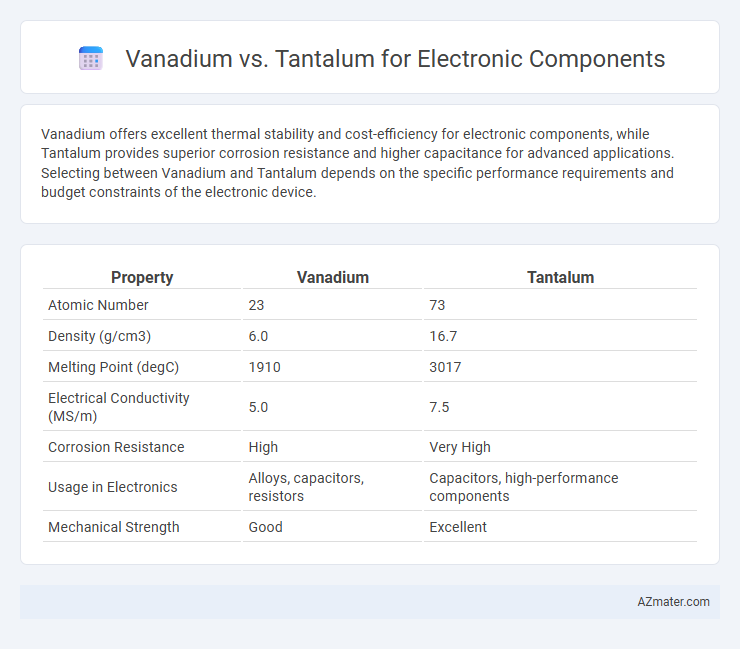Vanadium offers excellent thermal stability and cost-efficiency for electronic components, while Tantalum provides superior corrosion resistance and higher capacitance for advanced applications. Selecting between Vanadium and Tantalum depends on the specific performance requirements and budget constraints of the electronic device.
Table of Comparison
| Property | Vanadium | Tantalum |
|---|---|---|
| Atomic Number | 23 | 73 |
| Density (g/cm3) | 6.0 | 16.7 |
| Melting Point (degC) | 1910 | 3017 |
| Electrical Conductivity (MS/m) | 5.0 | 7.5 |
| Corrosion Resistance | High | Very High |
| Usage in Electronics | Alloys, capacitors, resistors | Capacitors, high-performance components |
| Mechanical Strength | Good | Excellent |
Introduction: Vanadium vs Tantalum in Electronics
Vanadium and tantalum serve distinct roles in electronic components due to their unique properties; vanadium exhibits excellent oxidation resistance and is utilized primarily in thin-film resistors and capacitors. Tantalum, renowned for its superior capacitance and corrosion resistance, is extensively used in electrolytic capacitors and high-performance microelectronic devices. The selection between vanadium and tantalum depends on factors such as capacitance requirements, temperature stability, and device miniaturization needs.
Elemental Properties and Atomic Structure
Vanadium and tantalum differ significantly in elemental properties and atomic structure, influencing their performance in electronic components. Vanadium, with atomic number 23 and a smaller atomic radius of 134 pm, features a body-centered cubic structure that provides good electrical conductivity and corrosion resistance ideal for thin-film resistors and capacitors. Tantalum, atomic number 73 with a larger atomic radius of 146 pm, has a body-centered cubic crystalline structure offering superior high-temperature stability and exceptional capacitance properties, making it a preferred material for electrolytic capacitors and chip components.
Electrical Conductivity Comparison
Vanadium exhibits moderate electrical conductivity, making it suitable for applications requiring durability with reasonable conductive properties, whereas tantalum demonstrates significantly higher electrical conductivity, preferred in high-performance electronic components like capacitors and microchips. The superior conductivity of tantalum, approximately 1.4 x 10^7 S/m, enables efficient current flow and minimal energy loss compared to vanadium's conductivity of about 1.8 x 10^6 S/m. This difference positions tantalum as the material of choice for electronics demanding optimal electrical efficiency and reliability.
Thermal Stability in Electronic Applications
Vanadium exhibits moderate thermal stability with a melting point of 1910degC, making it suitable for electronic components that operate under elevated temperatures but not extreme heat. Tantalum offers superior thermal stability with a higher melting point of 3017degC and excellent resistance to oxidation, enhancing reliability in high-temperature electronic applications such as capacitors and resistors. The choice between vanadium and tantalum depends on the required thermal endurance and specific operational conditions of the electronic device.
Corrosion Resistance: A Crucial Factor
Vanadium exhibits notable corrosion resistance, particularly in acidic environments, making it suitable for protective coatings and components exposed to harsh chemicals. Tantalum surpasses vanadium with exceptional resistance to most acids, including hydrochloric and sulfuric acids, ensuring longevity in aggressive corrosive settings. This superior corrosion resistance of tantalum makes it a preferred choice for capacitors, high-performance electronic components, and implants requiring stable, long-term durability.
Availability and Material Sourcing
Vanadium is more abundant than tantalum, primarily sourced from magnetite and petroleum residues, ensuring relatively stable supply for electronic components. Tantalum, rarer and often obtained from coltan ore in limited geographic regions such as the Democratic Republic of Congo, faces supply chain challenges impacting availability. Electronic manufacturers prioritize vanadium for cost-effective, sustainable sourcing, while tantalum's scarcity drives higher prices and ethical sourcing concerns.
Cost Efficiency and Market Trends
Vanadium offers a cost-efficient alternative to tantalum in electronic components due to its greater abundance and lower extraction costs, which significantly reduce overall material expenses. Market trends indicate a growing interest in vanadium-based capacitors and electrodes as manufacturers seek to balance performance with cost-effectiveness amid tantalum supply chain fluctuations. Despite tantalum's superior capacitance and stability, vanadium's cost benefits and evolving technology applications position it as a strong competitor in the electronics material market.
Common Electronic Components Using Vanadium
Vanadium is commonly used in electronic components such as vanadium oxide varistors, which provide voltage surge protection in circuits, and vanadium-based lithium-ion battery cathodes that enhance energy density and performance. In contrast, tantalum is primarily employed in capacitors for its excellent thermal stability and high capacitance per volume. Vanadium oxides' unique electrical properties make them essential for resistors, sensors, and smart windows in electronic applications.
Tantalum’s Role in Capacitors and Beyond
Tantalum's exceptional capacitance-to-volume ratio makes it a preferred material in high-performance capacitors for electronic components, providing stable electrical performance and reliability in miniaturized devices. Unlike vanadium, tantalum capacitors exhibit superior corrosion resistance and longer life cycles, crucial for applications in aerospace, medical devices, and consumer electronics. Beyond capacitors, tantalum's use in conductive coatings, alloys, and as a barrier material enhances device durability and efficiency in advanced semiconductor manufacturing.
Future Prospects and Sustainable Alternatives
Vanadium offers promising future prospects in electronic components due to its excellent corrosion resistance, high stability, and potential for use in energy storage applications like batteries and supercapacitors. In contrast, tantalum remains crucial for its superior capacitance and conductivity but faces supply chain challenges and higher environmental costs associated with mining. Sustainable alternatives, including vanadium-based materials and synthetic composites, are being explored to reduce dependency on tantalum while enhancing performance and environmental impact in next-generation electronic components.

Infographic: Vanadium vs Tantalum for Electronic Component
 azmater.com
azmater.com